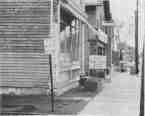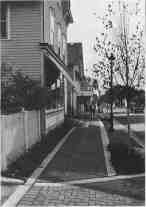PROJECT OF THE YEAR
ITASCA, ILLINOIS
Like so many communities, the Village of Itasca, a suburb of Chicago, experienced an evolutionary decline of its "Main Street" business district. With the advent of the automobile, the once bustling commercial center of this rural farming village fell victim to strip centers and regional malls in the 1960s and 1970s. Abandoned by local patrons, the area suffered through a period of deterioration and neglect.
In the early 1980s, the Village Board of Trustees realized revitalization of downtown was essential to the preservation of the unique character of the Village. In 1985, the Board established the Itasca Historical Commission. Its goal was to provide a plan of action for restoring the downtown area and fostering its quaint, turn-of-the-century character.
After two years, the Commission's exhaustive research led the Village Board to adopt an ordinance establishing an historic district in the downtown area, thus marking the beginning of the redevelopment project.
The major thrust of the Commission's redevelopment effort was restoration of historic structures, in the Village's original commercial center, to a pre-1900 motif. To assist in the restoration effort, the Village retained Planning Resources, Inc., and RJN Environmental Associates, Inc. of Wheaton, Illinois to develop an urban design plan for the area. The project included major streetscaping improvements designed to complement the restoration of historic buildings along Walnut Street.
The total project provided for building redevelopment, installation of new curbs and gutters, decorative sidewalks, new street lights, benches and trash receptacles, relocation of over-head electric utility lines, streetscaping and landscaping improvements. The project was completed in July 1990 to coincide with the Village of Itasca Centennial Celebration.
The Village implemented creative and innovative solutions to many of the problems faced during the course of the project. They include the following:
MIXTURE OF ARCHITECTURAL STYLES — A major impediment to improving the aesthetics of the

BEFORE PROJECT
|

AFTER PROJECT
|
May 1991 / Illinois Municipal Review / Page 15
downtown area was the random distribution of buildings of various architectural styles, constructed over a 100 year period. To respond to this problem, the Village established design criteria that preserved the pre-1900 motif of the Historical District.
USE OF BRICK PAVERS — Rather than conventional concrete sidewalks, interlocking brick pavers were used along the parkways. Brick pavers are similar to materials of the period, and can be easily removed and replaced should future underground utility work be necessary.
DESIGN OF PLANTERS — The narrow width of the parkways between existing buildings and the street right-of-way did not allow adequate room for both tree planting and pedestrian walking space. Unique 10 foot long planting areas were designed to foster root development of trees.
LINKAGE WITH EXISTING IMPROVEMENTS
— Prior to this project the Village had made substantial improvements to a community park and open space area just south of the Historical District. Similar design criteria was utilized on Walnut Street to complement the existing improvements.
FINANCING — In order to gain support of private business interests, the Commission and Village developed a unique public/private financing arrangement to assist business owners in their building restoration efforts. A $20,000 grant from a local bank was matched with $20,000 in Village funds to provide dollar-for-dollar matching grants of up to $8,000 for all business owners along Walnut Street wishing to restore their buildings to the pre-1900 motif.
ELEVATION OF EXISTING FOUNDATIONS AND PARKWAY — The abnormally high elevation of both the existing parkways and building foundations required that a number of terraced inserts be placed throughout the streetscape area to provide a more gradual descent from the parkway to the street level.
RELOCATION OF ABOVE GROUND UTILITIES — Existing above ground electric utility lines and poles were an unsightly distraction to the aesthetically pleasing improvements being planned. The Village worked with Commonwealth Edison to have all above ground electric utilities in the area relocated underground. In addition, the Village agreed to pay the costs of this improvement with the funds earmarked from the local hotel/motel tax.
MINIMIZING PUBLIC INCONVENIENCE — During the conceptual stages of the project, there was an obvious concern over the impact of construction on merchants in the project area. Prior to construction, Members of the Commission met with effected merchants to gain their support for the project. The merchants, fully aware of the upcoming inconveniences, were still overwhelmingly enthusiastic about the project. During the course of construction each merchant was provided a temporary access ramp. Merchants were informed about the progress of construction and contractors were asked to keep inconvenience to a minimum. During construction, resident engineering personnel monitored progress and responded to all merchants concerns.
ELIMINATION OF APATHY — In order to foster support for the project, the Commission and Village Board developed a unique incentive program for participants. The Mayor's Certificate of Excellence was awarded to owner's whose buildings were at least fifty years old and who maintained the original architectural features. The Pride of Place Award was presented to owners of new buildings whose design conformed with the established turn-of-the-century design criteria. The awards were designed to be placed in a prominent location on the exterior of each award winning structure.
The Itasca Historic District Development Project is a classic example of how the combination of the grass roots efforts of local citizens, action of local government leaders, support of the business community and technical consulting expertise can be marshalled to provide an aesthetically pleasing and viable solution to a major public works problem. Spurred on by the efforts of the Commission, the Village Board of Trustees took a strong and active leadership position and committed a generous amount of Village resources to the project. The business community responded with a major grant and overwhelming support in spite of the temporary inconveniences caused by construction. Finally, the engineers, planners, architects and other professionals were brought in at critical junctures to provide the necessary technical advice to make the project a reality.
This foresight and effort, was rewarded by the Chicago Suburban Chapter of the American Public Works Association when it presented the Village of Itasca the
Page 16 / Illinois Municipal Review / May 1991
1990 Local Project of the Year Award for the Walnut Street Redevelopment Project,
Further reward came from the citizens of Itasca in comments about the project:
"It makes me want to go downtown."
"It has changed peoples attitudes about downtown."
"The project makes people proud of the Village."
"The downtown redevelopment project is an investment that will pay off in the future."
For the citizens of Itasca, the Walnut Street Redevelopment project has meant not only a restoration of buildings and the rebirth of the commercial center, but also the restoration and rebirth of community identity and civic pride. It is this immeasurable benefit that has provided an accurate barometer of true project success to the citizens and the Village of Itasca. •
May 1991 / Illinois Municipal Review / Page 17